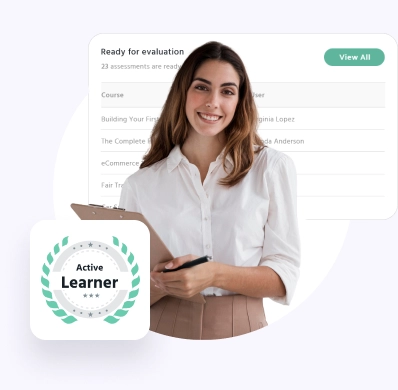- USA | UAE | INDIA
- Office Hour : 08:00am - 6:00pm
.


The advent of Learning Management Systems (LMS) has revolutionized how education is delivered in universities, schools, and colleges. The Talent Development LMS stands out as a robust platform offering a hybrid alternative to traditional classroom-based learning. With LMS, educational institutions can create a dynamic and inclusive learning environment that caters to the diverse needs of students. This flexibility has made LMS indispensable for institutions looking to enhance on-campus resources and expand their reach to learners globally.
By leveraging LMS, students can pursue self-paced learning or participate in instructor-led programs, ensuring a personalized education experience. Whether through online degree courses, blended learning environments, or virtual classrooms, LMS tools empower students to achieve academic excellence while accommodating their unique schedules.
The Talent Development LMS supports feedback-based learning, where student input shapes the educational process. This interactive approach focuses on creating a learning loop, where educators refine teaching strategies based on continuous student feedback. Key features include:
Feedback-based teaching ensures that education is not just delivered but evolves dynamically to meet student needs, fostering a growth-oriented academic culture.


Combining traditional lectures with modern collaboration tools, this approach enhances the learning experience by encouraging active participation. LMS platforms enable this by:
By integrating cooperative teaching into the LMS framework, institutions create a more engaging environment, boosting both retention and comprehension.
LMS platforms double as digital libraries, allowing students to access a vast repository of resources. This approach emphasizes the development of a strong knowledge base, equipping students with the skills necessary for multifaceted career opportunities. Features include:
Knowledge-based teaching helps students build a foundation for lifelong learning and professional success.


Interactive virtual classrooms facilitate meaningful discussions between students and educators. Hybrid learning models combine the benefits of face-to-face and online learning, ensuring:
This method encourages collaborative problem-solving and critical thinking, essential for modern education.
LMS platforms make project-based learning accessible and manageable. Students can participate in seminars, collaborate on projects, and showcase their work digitally. Benefits include:
This approach not only enriches the learning experience but also prepares students for real-world challenges.

Through experiential teaching methods, LMS allows students to gain practical knowledge by doing. Features that support this include:
This immersive learning style ensures that students graduate with the confidence and skills needed to excel in their fields.

LMS platforms adapt to the individual learning styles and paces of students, providing a tailored educational journey.
Interactive elements like gamification, quizzes, and multimedia content keep students engaged and motivated.
Educators can track performance data, analyze trends, and adjust strategies to improve outcomes.
Parents can monitor their child’s academic progress, fostering a supportive learning environment.
Students can learn anytime, anywhere, making education accessible to all.
Institutions can use the following strategies to increase LMS adoption:
Collaborating with Schools and Colleges
Talent Development LMS offers an opportunity for educational institutions to become partners, earning recurring commissions while delivering value. Benefits of this partnership include:
Align institutional objectives with LMS capabilities.
Develop a roadmap for seamless adoption.
Equip staff with the tools and knowledge to maximize LMS potential.
To create impactful online courses, institutions should follow these steps:
Transforming Higher Education with LMS
LMS platforms simplify administration, enhance engagement, and centralize educational resources. Institutions save time and costs while providing students with user-friendly, interactive learning experiences.
Benefits for Distance Education:
Key Goals:
Assignment Creation:
LMS platforms support various assignment types, including multiple-choice questions, essays, and interactive quizzes. Instructors can review submissions digitally, streamlining the evaluation process.

The future of education is here. With Talent Development LMS, institutions can create a smarter, more efficient learning environment that empowers students and educators alike. Together, let’s build the next generation of learning platforms.
Blended learning combines traditional in-person instruction with the flexibility and innovation of digital tools, making it a preferred choice for many institutions. Talent Development LMS plays a pivotal role in this transformation by enabling institutions to seamlessly integrate online and offline learning. Here’s how blended learning can reshape higher education:
Blended learning allows educators to cater to diverse learning styles. While some students thrive in interactive classroom environments, others excel with self-paced online modules. Talent Development LMS provides tools for:
Institutions can reduce operational costs by using LMS to minimize the need for physical resources. For example:
Blended learning fosters collaboration between students and educators through discussion forums, group projects, and real-time interactions. Features like live video sessions and peer feedback ensure an engaging, community-driven educational experience.
With Talent Development LMS, learning is not limited to the classroom. Students can access courses on any device, breaking down geographical and financial barriers to education. This inclusivity is particularly beneficial for:
A Learning Management System (LMS) is essential for modern educational institutions. It simplifies administrative tasks, enhances student engagement, and provides a centralized platform for managing learning resources. Key benefits include:
By adopting an LMS, universities can optimize resource utilization and improve educational outcomes.
The cloud-based architecture of modern LMS platforms makes them versatile and scalable, addressing various needs of educational institutions:
This comprehensive system enables institutions to deliver a seamless educational experience to students while maintaining administrative efficiency.
Distance education is becoming increasingly popular, and LMS platforms are central to its success. They enable institutions to deliver quality education to students irrespective of location.
This adaptability ensures that distance learners receive the same quality of education as their on-campus counterparts.
The ultimate aim of an LMS is to meet the educational and administrative needs of institutions while enhancing the overall learning experience. Core goals include:
By aligning with these goals, LMS platforms contribute to improving the quality of education across all levels.
Yes, LMS platforms like Talent Development LMS provide robust features for designing and managing assignments. Instructors can create various formats to suit different learning objectives, such as:
Assignments can be submitted digitally, and educators can review them efficiently, offering feedback to students in real time.
The Future of Learning Management Systems
Talent Development LMS is at the forefront of educational innovation, combining artificial intelligence with microservices architecture. These advancements ensure:
Are You Ready?
Join the revolution in education with Talent Development LMS. Together, we can create a next-generation learning platform that empowers students, educators, and institutions to thrive in the digital era. Let’s shape the future of education—today!
A Learning Management System (LMS) is a software application or web-based platform designed to manage, deliver, and assess educational or training programs. It serves as a centralized hub for content delivery, student management, and performance tracking, making it invaluable for educational institutions and organizations.
Content Delivery
An LMS provides a unified platform for creating and delivering educational content, which can include text, videos, audio files, and interactive elements. Learners can access this material at their convenience, ensuring flexibility and accessibility.
Student Management and Interaction
LMS platforms allow instructors and learners to communicate and collaborate through tools like discussion boards, chat rooms, and group projects. They also enable educators to track learner progress, provide feedback, and manage performance metrics.
Assessment and Reporting
Built-in tools for creating quizzes, assignments, and tests make assessments seamless. Detailed reporting features allow instructors to monitor learner performance, identify knowledge gaps, and refine course content as needed.
Integrations and Standardization
Most LMS platforms integrate with existing systems such as HR software, school databases, and CRMs. They support e-learning standards like SCORM and xAPI to ensure compatibility with various types of content.
Customization and Personalization
LMS platforms offer tailored learning paths to accommodate individual learning styles and paces. This personalized approach improves engagement and ensures better outcomes for learners.
Scalability
Whether for a small team or a large organization, an LMS can scale to accommodate an expanding number of learners, courses, and data, maintaining performance without compromise.
E-Commerce Capabilities
Some LMS platforms include built-in e-commerce tools, allowing institutions to sell courses online and reach a broader audience.
When selecting an LMS, it’s essential to match the platform’s features with your organizational needs. Here are some critical considerations:
LMS pricing depends on factors such as:
LMS platforms are widely used in both academic and corporate environments to:
When selecting an LMS, it’s essential to match the platform’s features with your organizational needs. Here are some critical considerations:
LMS pricing depends on factors such as:
An LMS simplifies the onboarding process, ensuring consistency and effectiveness. Through interactive modules, new employees can access training materials anytime, complete assessments, and gain a comprehensive understanding of their roles. Gamification elements, such as badges or leaderboards, can further enhance engagement and retention.
When selecting an LMS, consider the following factors:
With the right LMS, organizations can streamline learning processes, foster engagement, and achieve educational or training goals efficiently.